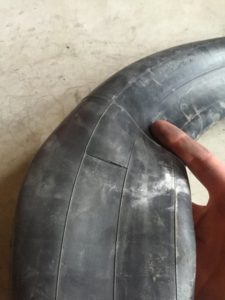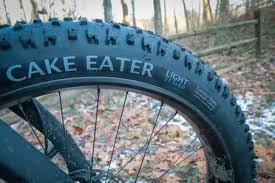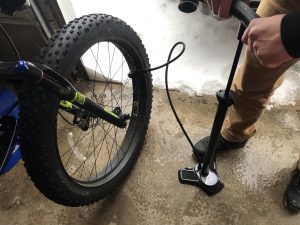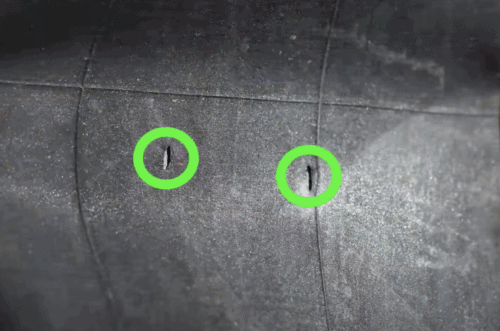Any time a person gets on their bike, they risk having some type of tire issue that holds them up. Some are pretty obvious when they happen, such as running over a nail or something similar that causes a puncture to the tire.
There can even be a problem with the bike itself, but what about something a bit more out of the blue?
A pinch flat is one of those annoying problems that seemingly hit at the worst time. Everything with the ride can be going perfectly well, but the tire instantly loses air and can’t be easily fixed.
We want to take a look today at pinch flats, and how to avoid them as much as possible. Making even a few minor adjustments will reduce the risk of a major hold-up.
What Is a Pinch Flat?

A pinch flat, also known as a snakebite puncture, is when a rider hits a sharp edge with the bike tire. This edge is just enough that it presses on and pinches the inner tube against the rim so that it is compromised.
A true pinch flat creates two small holes side-by-side on the inner tube for a flat tire. Having two holes to deal with is a little bit more troublesome to say the least, but it can be fixed to make it home.
Since a pinch flat can happen at any time, it’s recommended to have the basics to fix things. This is going to be the difference between having a call for help in a remote area, and being able to make it at least home somewhat quickly.
A fixed inner tube might not last all that long, but as long as the bike is still functioning to some degree, it will be good enough to finish the vast majority of rides.
Ride a bike long enough with inner tubes, and this type of problem inventively hits. Total avoidance with an inner tube seems impossible, but there are ways to reduce the risk.
Tips For Avoiding a Pinch Flat
Pinch flats have been around for a very long time, and it seems like there is no way to totally avoid them when using an inner tube.
Tubeless is one option, but we will take a look at all the different ways that people can reduce their risk as much as possible.
In some cases, a rider might not be able to go with a tubeless setup, so cutting back on the chances of a pinch flat can still be beneficial for them.
Install Thicker, Heavy Duty Tires

With so many people trying to cut weight, it sometimes becomes a bit of a negative since it is putting people in a vulnerable position for a pinch flat.
Riders who might not necessarily care about going top speeds and want to stay away from flats can install stiffer and heavier tires overall.
A major reason why most wider tires do such a great job handling pinch flats is that they usually have thicker rubber. It’s not so much about cutting weight and performance as it is being durable.
Road cyclists are always caught up with going as light as possible for the setup, but it makes everything a bit more vulnerable overall.
There is really no excuse not to pay a little more for thicker, more durable tires for mountain and fat bike riders. They usually end up paying for themselves, and one of the factors to consider is the reduced risk of a pinch flat.
Properly Inflate The Tires

A pinch flat is an issue that pops up more often when the tires are under-inflated. Mountain and fat bike riders specifically have some issues with pinch flats, because they are trying to smooth out the ride with a low PSI.
While there are some benefits to lowering the PSI, pinch flat risk goes up. What happens is that whenever a bike hits a pothole or some other bump in the road, it has a good chance of pinching the tube inside.
All types of riders are vulnerable to pinch flats, but proper inflation will help to some degree. For example, even road bike riders who have properly inflated tires still have very little margin for error.
There is not a lot of tire to protect the tube inside, so the chances of getting pinched against the rim is pretty high. If they are under-inflated, the risk shoots up, and a rider is practically asking for a flat tire.
Make sure to check air pressure frequently to avoid any issues with a pinch flat. It’s not uncommon for some people to go ahead and check air pressure before every single ride.
Tires lose air pressure even if they are not being used, so checking at least once a week is necessary when actively riding.
Go Wider
Wider tires do a better job of cutting down the risk of pinch flats compared to narrow options. That’s because they contain more protective air volume overall.
If possible, go with a wider tire if pinch flats are happening way too frequently. Forks are designed to handle a certain range of tires, so make sure beforehand that the bike can go with something wider before making the upgrade.
It needs to have enough clearance for wider tires, so get some measurements at a local bike shop, or look online.
If the plan is to go with two different types of tires on the bike, opt for the widest tire possible on the rear. The front tire could be a little bit narrower and still not cause any major issues. It also makes the bike a little bit easier to handle.
Don’t Be Afraid to Float
Every single rider has seen an upcoming obstacle that poses a potential risk. It seems inevitable that something bad is going to happen, and tires can certainly be compromised with a snakebite puncture when this is the case.
Trying to float over a hazard will help out significantly for those who have had problems getting flats in that particular area.
The thing to keep in mind is to try to be as light as possible when going over these tough surfaces. Try to lift the body and knees to prepare for contact.
Level out the pedals, take the butt off of the saddle so that it’s not putting extra weight on the tires, and try to float over the hazard to get through it all.
Making everything heavier will cause some pretty big issues and increase the odds of a flat.
Go Tubeless
There’s a reason why there are so many different riders out there these days who have turned to tubeless tire setups.
This is a great way to avoid those pinch flats since there is one less thing to worry about. With the inner tube completely eliminated, people can benefit from such a vulnerable piece getting a whole.
Tubeless tires on a bike, as the name suggests, is all about helping modern riders get a better overall experience.
For example, a tubeless setup helps reduce weight, cut down on rolling resistance, and increase the ability to ride with lower tire pressure. With the right setup, it can be a very comfortable ride that people start to use, and never look back.
Of course, another great thing about tubeless tire bikes is that they allow people to go back to an inner tube if they really want to.
There’s a lot more flexibility with these types of bikes compared to what else is out there on the market. No one is forced to go entirely tubeless if they end up not liking the setup.
Eliminating the risk of a snakebite puncture definitely has more than a few benefits for anyone who has suffered through them in the past.
The Final Word on Pinch Flats
As long as the inner tube is present in any bike, there’s going to be some risk of a pinch flat. Reducing those risks is relatively easy by being a little bit smarter about it, but nothing is a guarantee.
Tubeless tires definitely help provide some benefits, but it’s not a perfect solution that works for every single person out there.
Ultimately, trying a few different setups will likely give each rider a feel for what they really want. Some will love tubeless and never go back, while others will take the reduced chances with an inner tube by using some of the tips above.
Remember always to be ready with some repair material if a pinch flat does happen out on a ride. It’s not the end of the world if it does happen, but it does tend to ruin the day.


One thought on “What Are Pinch Flats And 5 Ways To Avoid Them”